2. GHANA
Ghana¡¯s timber exports register growth
Ghana earned euro 9.17 million from the export of 21,028
cubic metres of wood products in January. By way of
comparison exports for January 2013 were up by 47% in
terms of value and almost 18% higher in terms of volume
on levels in the same month in 2012.

January 2013 exports of primary products (Poles and
Billets) amounted to euro 160,904 and 665 cubic metres.
January exports were lower than in the same month in
2012 (down 51% in volume and 71% in value). Analysts
say the main reason for the decline was the scarcity of
logs.
Secondary wood products, mainly sawnwood, boules,
veneer and plywood comprised the bulk of the country‟s
January wood product exports. Exports of secondary
products generated euro 8.28million from a sale of 19,037
cubic metres.
Exports of tertiary wood products such as mouldings,
flooring, dowels and profile boards earned euro 727,355
from a volume of 1,326 cubic metres in January.
African countries were the major destination for Ghana‟s
wood product exports, accounting for some 43% of export
revenues.
The ECOWAS market accounted for approximately 44%
of the total value of exports to African countries and
exports were mainly of plywood and sawnwood to
Nigeria, Niger, Senegal,. Burkina Faso, Togo, Benin and
Mali.
Inflation proving difficult to tame
Ghana's annual producer price inflation rose to 10.7
percent year-on-year in March from 9.1 percent in
February according to the National Statistics Office.
Producer price inflation is an advance indicator of
consumer price inflation (CPI), which the government
aims to hold within single digits. The CPI rose to a fresh
three year high of 10.4 percent in March from 10.0 percent
the previous month.
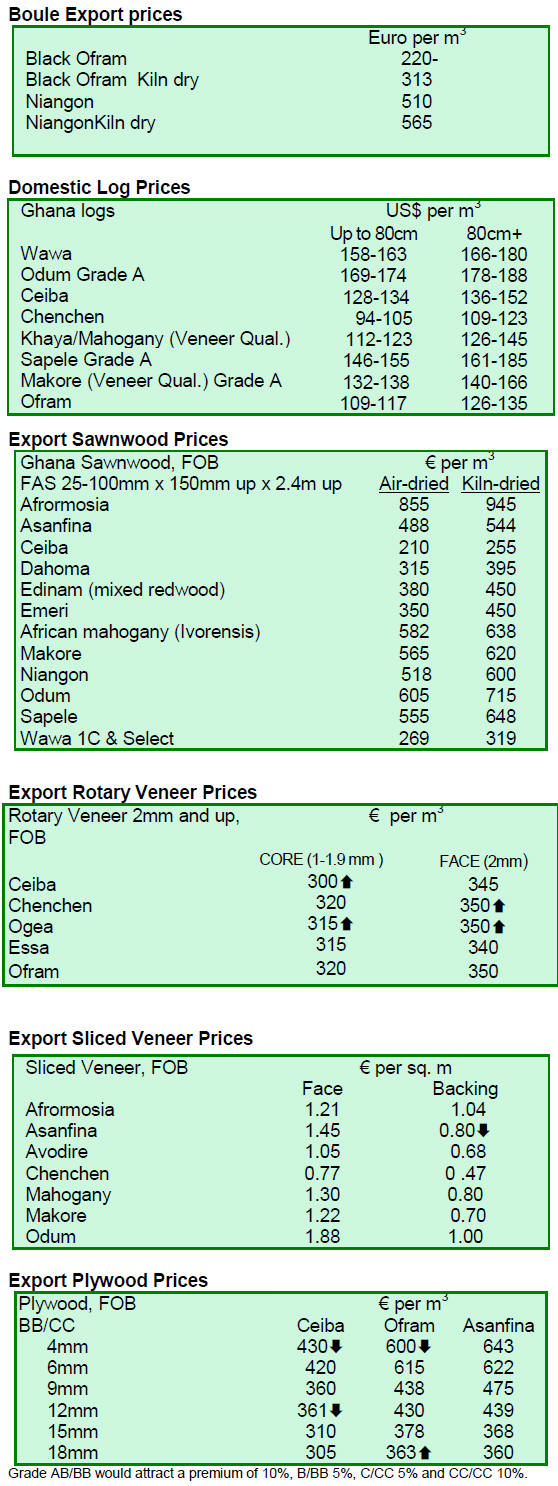
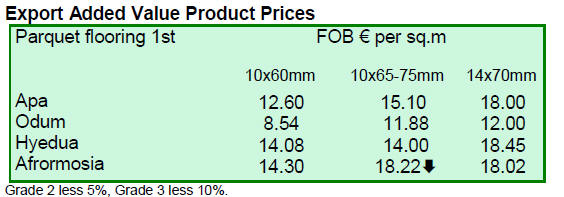
3. MALAYSIA
Malaysia¡¯s main trading partner - China
The Malaysia External Trade Corporation recently
reported that China continues to be Malaysia‟s largest
trade partner.
In 2012, trade between Malaysia and China amounted to
RM180.6 billion (approximately US$58.6 billion), an
increase of 13 per cent compared with the previous year.
Of this total, Malaysia‟s exports to China were worth RM
88.75 billion (approximately US$28.8 billion) and imports
from China RM 91.86 billion (approximately US$29.8
billion).
The main reason cited for the trade imbalance was the
declining price of commodities such as palm oil and
rubber, both of which were exported to China.
VPA to be concluded by year end
Malaysia‟s Ministry of Plantation Industries and
Commodities has indicated it hopes to conclude
negotiations and sign the Voluntary Partnership
Agreement (VPA) with the European Union (EU) by yearend.
The national news agency BERNAMA quoted the
ministry's advisor, Dr Freezailah Che Yeom as saying
"One of Malaysia's initiatives to ensure an uninterrupted
flow of wood exports to the EU until the VPA is
concluded includes the Malaysian Timber Legality
Assurance System."
In a recent workshop on timber legality assurance,
representatives of the European Forest Institute (EFI) said
Malaysia has made good progress in drawing up its
legality assurance system as a first step in the VPA
process.
The workshop was organised by the EU FLEGT Facility
and the ASEAN Secretariat and attracted some 70
participants from seven ASEAN countries, the EU and
Ghana.
The workshop provided an opportunity for participants to
exchange experiences as well as explore increased
collaboration on timber legality among agencies and
stakeholder groups in Southeast Asia.
In addressing the workshop the EU Ambassador and Head
of Delegation to Malaysia, Luc Vandebon, said "Countries
that have Forest Law Enforcement, Governance and Trade
(FLEGT) VPAs with the EU will be able to export their
timber on a fast "greenlane" because EU timber operators
are looking for an assurance that the timber they place on
the market is legally harvested."
The EU, a key market for value-added timber and timber
products such as furniture, is Asia's second largest export
market for sawn wood and plywood.
Malaysia's timber and timber product exports to the EU
last year were worth RM20.197 billion (approximately
US$6.6 billion).
Ambassador Vandebon said strengthening forest
governance should be a priority in implementing effective
policies to conserve and sustainably manage resources so
as to reduce unintended deforestation.
Sarawak plywood exporters encouraged by growth in
Japanese demand
The Star newspaper reported Shin Yang Group executive
director, Wong Kai Song as saying Japan's higher housing
starts this year had spurred demand for imported
woodbased panel products. Shin Yang is the largest
producer of panel products in Sarawak with six plywood
mills.
Japan is increasing imports of plywood from Sarawak as
reconstruction activity has gained momentum in coastal
towns devastated by the earthquake and tsunami two years
ago.
¡°Japanese housing companies are now very busy with
reconstruction work although they are facing a shortage of
carpenters. This year's new housing starts in Japan were
around 900,000 units, which is about 10% higher than
820,000 units last year,¡± Wong said.
Statistics from the Sarawak Timber Association show
Japan imported 1.44 million cubic metres of plywood from
Sarawak in 2012, compared to 1.31 million cubic metres
in 2011.
About 55% of the state's total export of 2.64 million cubic
metres last year went to Japan. Sarawak's total exports of
plywood in 2012 were 16.5% higher than the 2.27 mil.
cubic metres in 2011.
Wong said the average price of Sarawak plywood in the
Japanese market rose by about 15% to US$550 (RM1,670)
per cubic metre in the first quarter of this year thanks to
the stronger demand. ¡°There is another 5% to 10% upside
potential in the price,¡± he added, in anticipation of further
growth in Japanese demand.
Anti-dumping duty little impact on Sarawak plywood
exports to S. Korea
In 2012 South Korea increased its imports of plywood
from Sarawak by 38% to 331,600 cubic metres up from
239,900 cu m in 2011. This was despite the imposition of
an anti-dumping duty on Malaysian plywood which
remains in force.
The anti-dumping duties imposed by South Korea on eight
Sarawak and one Sabah plywood exporters range from 5%
to 38% and will remain in force until February 2014.
4. INDONESIA
Opportunities for international trade in
Indonesian
plantation logs
Media reports suggest that the Ministry of Forestry is
considering lifting the log export ban to provide an
incentive for the further development of industrial
plantations.
The log export ban has been in effect since 2001 but the
Association of Indonesian Forest Concessionaires (APHI)
has said the ban has resulted in a marked decline in log
prices.
Current market prices for plantation logs are in the region
of US$30-40 per cubic metre, significantly lower than the
regional average because plantation owners can only sell
in logs on the domestic market where fierce competition
has driven down prices.
Under the present conditions there is little incentive to
invest in forest plantations.
The Ministry of Forestry plans to create the conditions for
a viable international trade in Indonesian plantation
timbers so that its target for annual plantation
establishment of 500,000 hectares of industrial forests can
be achieved.
In 2011 only 374,000 ha of new plantations were
established, around 75% of the government target and in
2012 only about 400,000 ha were established.
SVLK to assure legality of export logs
One of the main reasons for the implementation of the log
export ban was to help eliminate illegal logging. However,
conditions in Indonesia are now very different as the
country has a rigorous timber legality verification system
(SVLK) which is providing Indonesian exporters with
greater access to markets where proof of legality is
demanded.
In related news, the government is planning to extend the
moratorium on forest clearance, introduced following an
agreement between Indonesia and Norway on assistance to
reduce greenhouse gas emissions and deforestation in
Indonesia.
Green Peace in Indonesia, while welcoming the extension
of the moratorium on forest conversion, expressed concern
that a lifting of the log export ban could result in an
increase in illegal logging.
To open or not, the mining concession debate in Aceh
Province
Unconfirmed reports suggest that the Ministry of Forestry
has approved plans by the Aceh administration to open
around 1 million hectares of forests for mining
prospecting; 400,000 hectares for logging; and 250,000
hectares for conversion to oil palm plantations.
News of this resulted in immediate calls from NGOs and
others for the decision to be withdrawn.
Media reports say Gracia Paramitha, the United Nations
Environment Program, Tunza Global Youth Advisor, said
¡°1.2 million hectares of protected forests in Aceh had been
converted into industrial plantations¡±, adding that this
figure was already too high.
This week, East Asia Minerals said in a press release
(http://archive.is/taeU6) „the Ministry of Forestry is close
to accepting a proposal to open 1.2 million hectares of
forest in Aceh province for mining, logging, and palm oil
production¡±.
The CEO of East Asia Minerals was quoted in the press
release as saying "We are very pleased with the recent
news from the Indonesian Government.
These new developments are good progress and positive
news for mineral extraction in the area. This will help us
realize the full value of our Miwah gold project in Aceh
with a forecast resource of 3.1 million ounces of gold."
Policies needed to unlock economic benefits of urban
agglomerations
Indonesia‟s economy grew throughout 2012, but the
World Bank‟s March 2013 edition of the Indonesia
Economic Quarterly (IEQ) notes that domestic economic
and policy pressures are mounting.
GDP growth for 2012 was 6.2 percent, down slightly from
6.5 percent in 2011. The World Bank forecasts a 6.2
percent growth in 2013 but warns that improving the rate
of growth will be challenging.
Stefan Koeberle, the World Bank Country Director for
Indonesia said ¡°With the right policies in place, Indonesia
could move growth higher, harnessing the forces of
urbanization and rising incomes, while providing quality
jobs for a growing labour force.¡±
The biggest risk to short-term growth will be a drop in
domestic investment which recently slowed, in the capitalintensive
resource sectors.
The Bank says the investment climate would benefit from
improved certainty in the regulatory environment.
Investment is also crucially needed in infrastructure which
continues to constrain growth, causing bottlenecks and
high logistics costs. Infrastructure investment remains at
around 3 to 4 percent of GDP, compared with pre-Asian
crisis levels of around 7 percent.
The infrastructure challenge for many of Indonesia‟s cities
is particularly acute - more than half of Indonesia‟s
population live in urban areas, and the pace of
urbanization remains high.
Improving the level, quality and efficiency of
infrastructure investment can help to unlock the economic
benefits of urban agglomerations and support the quality
of service delivery, particularly in mid-size cities that lag
behind smaller urban centres and the ¡°mega-cities¡±.
For the World Bank press release see:
http://www.worldbank.org/en/news/pressrelease/
2013/03/19/indonesia-steady-growth-butpressures-
mounting
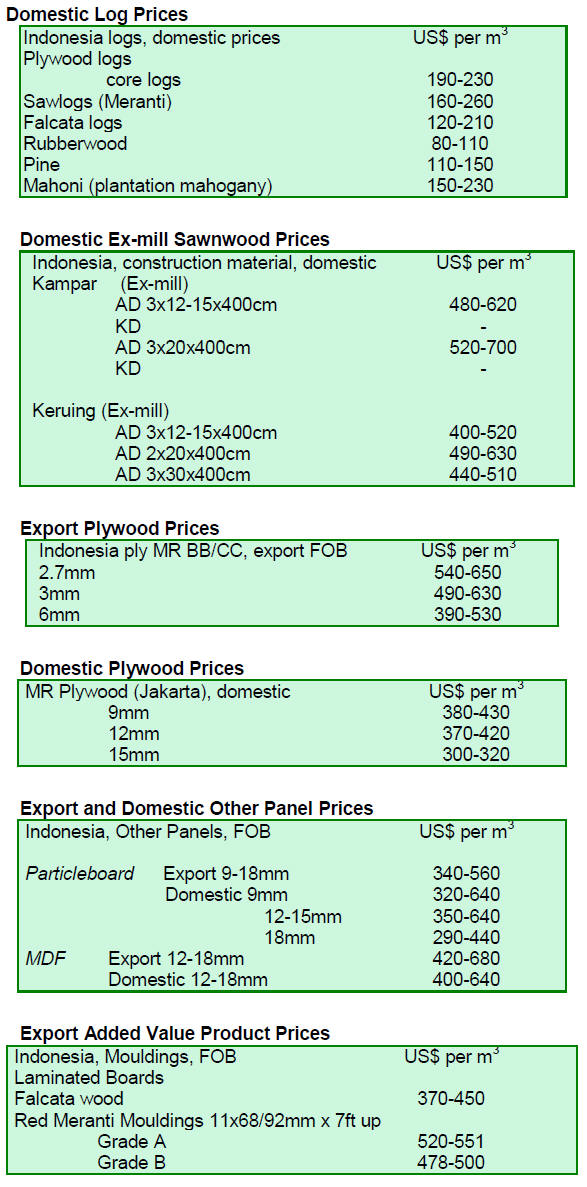
5. MYANMAR
Business activity in Myanmar has slowed to
almost zero as
everyone celebrates the New Year this month.
ADB upbeat on prospects for Myanmar
An easing of sanctions in Myanmar, along with rising
exports and business enthusiasm, will fuel annual growth
of more than 6% for the next two years provided the
government stays the course with its reform programme,
says a new Asian Development Bank (ADB) study.
See the related press release at
www.adb.org/news/myanmar/myanmar-grow-stronglyreforms-
roll-out-investmentrolls?
ref=countries/myanmar/news
¡°The outlook for the Myanmar economy is the brightest it
has been for decades with investment, exports, tourism,
and business optimism all on the rise. However this
positive outlook could be at risk if the forward momentum
of policy reforms falters or if recent tensions escalate
further¡±, said ADB Chief Economist, Changyong Rhee.
The ADB „Development Outlook 2013‟ forecasts an
annual GDP growth in Myanmar of 6.5% in the year to 31
March 2014, rising to 6.7% in 2014.
In 2012, the economy expanded an estimated 6.3%, well
above the annual average of 5% recorded over the
previous five years.
Proposed tax reforms and greater financial autonomy for
state enterprises, coupled with increased export receipts,
should give the government more fiscal leeway to step up
spending on social services and infrastructure, while also
lowering the fiscal deficit, says the ADB report.
This will also help reduce an over-reliance on natural
resources revenues, which currently make up nearly a
quarter of all public revenue.
Although the policy reform agenda may take years to yield
results, the report underscores measures to deliver benefits
within two to three years, such as increasing the
participation of private banks in the economy, and easing
restrictions on interest rates and lending.
Simplifying business registration and visa procedures for
tourists, upgrading inefficient power systems, and
increasing access to finance and other services in the
agriculture sector, would also be beneficial in the short
term.
Singaporean company capture major construction
contract
The Myanmar Mizzima News of 11 April reported that a
Singaporean firm has won a US$74 mil. construction
project. The company, Bouygues Construction, will be
contracted to build the second phase of Yangon‟s Star City
in a joint venture with Serge Pun‟s SPA Project
Management ltd., Myanmar.
Some 500 jobs will be created and workers will be trained
in modern construction techniques. The residential estate
will feature 4980 apartments and community facilities
along the Bago River in outer Yangon. Analysts anticipate
a rise in domestic consumption of wood products when
construction begins.
In related news the Singaporean government has
reportedly upgraded its business presence in Myanmar in
an effort to secure business opportunities. The government
agency International Enterprise Singapore has opened an
office in Myanmar and is sponsoring trade visits.
US dollar replaces euro in teak auctions
Beginning this month the Myanma Timber Enterprise has
changed to using the US dollar for teak pricing, the euro
will no longer be used.
Bidding at the latest auction was reported as quite
competitive. Buyers from India and Pakistan actively
participated in the bidding and prices increases were
observed for all teak log qualities.
The following prices were recorded during the teak
auctions on 26th and 29th April 2013.

6.
INDIA
Prospects for an interest rate cut improve
The Wholesale Price Index, a widely watched measure of
inflation, dropped to 5.96% in March, the lowest in the
past forty months. The March level compares to an overall
rate of inflation of 9 % during last year.
The decline in inflation, coupled with an easing of prices
for crude oil and gold, is reducing India‟s current account
deficit since both these commodities feature prominently
in India‟s finances.
If the current economic conditions are maintained then the
prospects for a reduction in interest rates improve and this
would greatly assist the wood product manufacturers
directly and through improving the affordability of
housing and thus stimulating demand.
Export incentives announced
In the latest annual foreign trade policy decision the
scheme for duty free imports of capital goods has been
extended and made available to all industrial sectors.
Moreover, exporters are now entitled to an additional two
percent export duty credit on the incremental value of
shipments. This additional credit will be over and above
the scheme for duty credits ranging from two percent to
five percent all ready being provided.
These benefits were introduced during 2012-13 as exports
fell almost 2%. Supporting a growth in exports is
important, not only to help reduce the current account
deficit but also to ensure growth in employment.
The Indian government has also introduced measures for
simplification of the procedures for value added tax
refunds and a reduction in transactional costs has also been
introduced.
Growth in exports at risk from EUTR
Indian exporters are of the view that the EU timber
regulation (EUTR) will adversely affect trade as the
formalities that must be met will increase costs and could
cause shipments to be delayed.
Recently, meetings were held between representatives
from the European Forest Institute, EU FLEGT Facility,
government officials, export promotion council officials
and the media to discuss the requirements of the EUTR
and its possible impact on Indian exporters.
According to provisional data, India‟s exports of wood
products increased 72% year on year to US$270 million
during the period April 2012 to January 2013 and the EU
was a major market.
Indian handicraft producers fear losing EU market
According to the Indian Handicrafts Export Promotion
Council, approximately 1.1 million artisans are employed
in the manufacture of wooden handicrafts and the sector is
a major contributor to economic growth.
As many of these manufacturers also export products they
fear losing market opportunities in the EU as a result of
the EUTR.
The major importers of Indian wooden handicrafts are
Australia, Canada, France, Germany, Italy, Japan,
Netherlands, UAE, Switzerland, Saudi Arabia, USA and
UK.
Demand for Indian handicrafts has been increasing in both
international and domestic markets. Exports of wooden
handicrafts were worth US$325 million in 2011-12 and
US$507 million for 2012-13.
The export council has organized seminars and training
programmes on compliances and certification for wooden
handicrafts exporters at some of the major craft clusters
and continues to disseminate information.
However, for the small artisans, tracking wood flows and
timber legality issues are far beyond their capabilities.
The EUTR applies to all products made from imported as
well as locally sourced timber so will impact thousands of
small and medium sized enterprises producing
reproduction antique furniture, doors, windows, panels and
wooden household utility items.
An expert committee has been constituted by the
Handicraft Council to assess the supply chain against the
various timber legality requirements of EUTR, Lacey Act
and others. The aim is to achieve international credibility
for Indian exporters.
A major effort is underway in India to see that the supply
of legal timber is sustained so that wood product export
growth is not adversely affected and that employment
opportunities are maintained.
Improved harvesting conditions eases log shortage
In the recently concluded auction sales at government
forest depots in the Jabalpur, Hoshangabad and Betul
divisions of Central India, approximately 10,000 cubic
metres of mainly Teak, Haldu and Laurel were sold.
As there is a serious shortage of domestic logs, these
auctions supplied acutely needed resources for industry.
The weather conditions for harvesting are currently good
and additional log stocks are expected at the depots. The
following prices were recorded at the recent auction.

Imported teak logs and sawnwood
Supplies and shipments of teak logs and sawnwood were
steady and prices have been generally stable with just a
few exceptions. There is active trade in imported timber as
domestic resources are limited.

Imported KD 12% sawn wood
Domestic demand for imported kiln dry sawnwood is
growing and imports from the US have been increasing.
Ex-sawmill prices for air dried sawnwood remain largely
unchanged except for slight increases in prices for US
hardwoods, a reflection of exchange rate movements and
an overall increase in US hardwood log prices.

Plymill productivity rises as log availability
improves
Plywood manufacturers report improved demand and
some improvement in log supplies which is lifting mill
productivity. Plywood prices remain unchanged after the
recent increases and are as shown below.
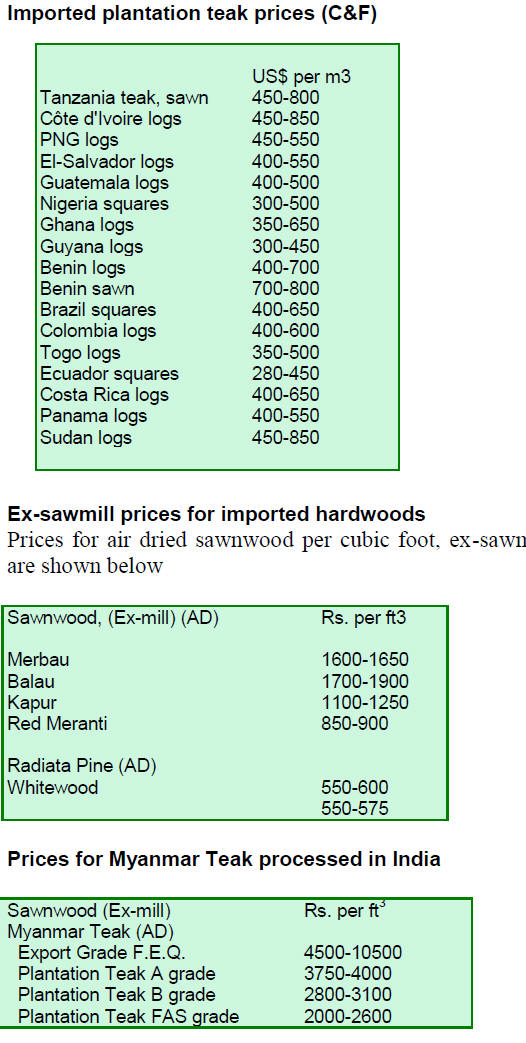
¡¡
7.
BRAZIL
Furniture sector showing signs of
weakness
Furniture production in Brazil increased in March but the
rate of growth was lower than that observed for the same
month in the past two years.
Analysis of production data suggests that average
utilisation of installed capacity in the furniture
manufacturing sector during March was lower than that in
either March 2011 or 2012.
Of the various constraints facing the furniture sector the
rising costs of raw materials and a heavy tax burden are
often cited. Prices of raw materials for the industry rose
significantly in the first quarter of 2013 according to the
National Confederation of Industry.
The weaker than expected performance of the furniture
sector over the past few months, coupled with rising
production costs, affected the financial standing of
companies. Adding to the woes of the sector is the
difficulty faced in securing competitive credit services.
Results of FIMMA Brazil 2013 Exceed Expectations
The 2013 International Machinery, Raw Material and
Accessories fair - FIMMA Brazil - was declared a success.
Some 653 exhibitors and 45,443 visitors from 41 countries
attended the fair. For more see
http://www.fimma.com.br/en/
This was the eleventh fair and the largest for the furniture
sector in Latin America and fifth largest worldwide.
Estimates put the level of business transacted at US$ 439
million, about 9% higher than during FIMMA 2011.
The fair provided companies with access to development
opportunities, facilitated access to new technological
developments and showcased cutting-edge initiatives from
around the world.
For companies interested in expanding their international
markets, the FIMMA ¡°Buyer Project¡±, a buyer meet seller
initiative, provided the opportunity for companies to forge
business partnerships. It is estimated that the ¡°Buyer
Project¡± generated US$7.15 million in business from the
numerous business meetings that were held involving 20
foreign buyers from eight countries and 72 exhibitors.
Tropical plywood exports rise in otherwise quiet
market
In March 2013, wood products exports (except pulp and
paper) fell 9.8% compared to values in March 2012, from
US$221.2 million to US$199.5 million.
Pine sawnwood exports also fell, reversing a recent
upward trend. March exports of pine sawnwood declined
14.2% in value compared to March 2012, from US$14.1
million to US$12.1 million. In terms of volume, exports
fell 14.3%, from 63,800 cu.m to 54,700 cu.m over the
same period.
Exports of tropical sawnwood fell sharply by 20.4% in
volume, from 40,100 cu.m in March 2012 to 31,900 cu.m
in March 2013. In terms of value the decline was even
more significant falling almost 30% from US$22.3 million
in March 2012 to US$15.7 million in March this year.
Pine plywood exports also fell dropping 4.9% in value
from US$ 34.5 million to US$ 32.8 million. The volume
of exports fell marginally (minus 3.6%) from 89,700 cu.m
to 86,500 cu.m. (March 2012 ¨C March 2013).
In a surprising reversal of the downward trend for other
woood product exports, in March this year tropical
plywood exports increased 21.6%, from 3,700 cu.m in
March 2012 to 4,500 cu.m in March 2013.
However, average prices dropped as the total value of
exports in March 2013 were almost the same as in March
2012, US$ 2.7 million.
Brazil‟s exports of wooden furniture dropped from
US$38.2 million in March 2012 to US$35.9 million in
March 2013, a 6.0% decline.
Challenging the Chinese market for luxury furniture
According to research of the global luxury furniture
market undertaken by the Federation of Industries of Santa
Catarina State, opportunities could be generated for the
export of Brazilian furniture to China.
It was determined in the Federation study that demand in
the Chinese market for high class western-style furniture
could be an opportunity for Brazil. It was determined that
consumers in this segment of the market pay high prices
for quality western designs.
The Federation study suggests that if Brazilian furniture
manufacturers want to capture a share of the up-market
furniture market in China then attention must be placed on
developing brand image.
The Chinese market for top-end furniture is concentrated
in Shanghai and Beijing and is currently dominated by
Italian and German brands, according to the study.
Remarkable data on per capita consumption of furniture in
China is also reported in the study. Apparently, annual per
capita consumption of furniture in China is higher than the
world average.
The Federation report says while the world average is
US$50.00 per person per year, in China the average over
recent years was US$ 75.00 per person per year.
The latest data available for Brazilian exports to China are
for 2011 when five Brazilian companies exported just
US$62,000, almost nothing compared to the US$91
million from Italy and the US$89 million from Germany.
Furniture exporters face difficult trading conditions in
international markets
First quarter 2013 data shows that the Brazilian furniture
sector began the year on an encouraging note. Demand in
the domestic market was good however; the good news
was tempered by difficult trading conditions in the
international markets.
In January 2013, according to the National Confederation
of Industry (CNI), the furniture sector in Brazil ranked
fifth among 16 industrial sectors in terms of growth.
Growth in the furniture sector was reported as 11.7% in
January, a figure that is higher than the average for all
sectors examined.
Brazilian furniture exports have been disappointing.
During the period from March 2012 to February 2013, the
furniture industry exported approximately US$ 457
million, 11% lower than that of recorded over the same
period one year earlier.
The Rio Grande do Sul furniture cluster accounted for a
26.6% share of Brazil's international furniture sales,
(US$11,858,942). However, overall national data indicate
stagnation in furniture exports in recent years.
On the other hand Brazilian furniture imports have
continued to grow. From January to December 2012,
imports totaled US$ 27 million, approximately 79% higher
than imports in 2011 (US$17 million).
In January and February 2013, furniture imports continued
the upward trend and the average monthly growth was
1.9% over the past 12 months.
Central Bank rate cut, first since July 2011
According to the Brazilian Institute of Geography and
Statistics (IBGE), Brazil‟s consumer price index (IPCA)
touched 0.47% in March, which is below the 0.60% rate
recorded in February.
In March the inflation rate was 0.21% and the
accumulated rate of inflation over the past 12 months was
6.59%, a level exceeding the upper limit target set by the
Brazilian Central Bank (BCB).
In the foreign exchange markets the average exchange rate
to the US dollar in March was BRL 1.98/US$ compared to
BRL1.79/US$ in March 2012 indicating a slight
depreciation of the Brazilian currency against the dollar.
The Monetary Policy Committee of the BCB raised the
prime interest rate (Selic) by 0.25 percentage point at its
meeting in April. This was the first increase in rates since
July 2011. Interest rates now stand at the equivalent of
7.5% per year.

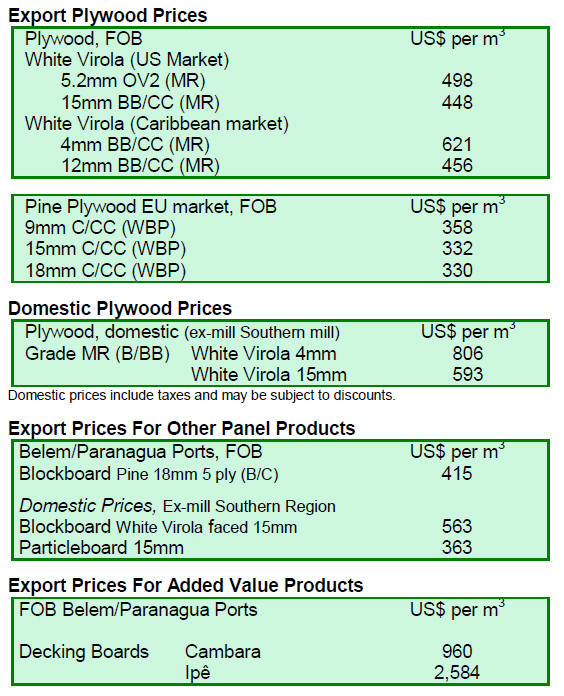
¡¡
8. PERU
Sector financing opportunities for
downstream
manufacturers
In order to promote and strengthen financial management
capabilities in enterprises a seminar, "Application of
financial mechanisms for industrial wood production¡±,
was recently conducted as part of an ITTO project.
The aim of the project is to improve the productivity of the
Peruvian timber industry to develop higher value-added
products.
This seminar was aimed at entrepreneurs and business
professionals from primary and secondary wood
processing enterprises and was attended by more than 65
forestry enterprises.
During the workshop representatives from the National
Forestry Camera, the Agricultural Bank and from the
private sector company, Orvisa S.A. presented suggestions
and ideas on management techniques and sourcing
investment capital.
As this first workshop was such a success it will be held
again for companies in Pucallpa and Aguayt¨ªa during the
first half of May.
Agrobanco opened offices in the Amazon
In order to provide forestry and agri-business companies
with access to finance Agrobanco, a state financial entity,
has opened two new offices, one in the town of Puerto
Inca and the other in Quillabamba, both in the Peruvian
Amazon.
In the case of forestry, Agrobanco will provide financing
to companies with forest concessions as well as companies
that are undertaking reforestation of degraded forests.
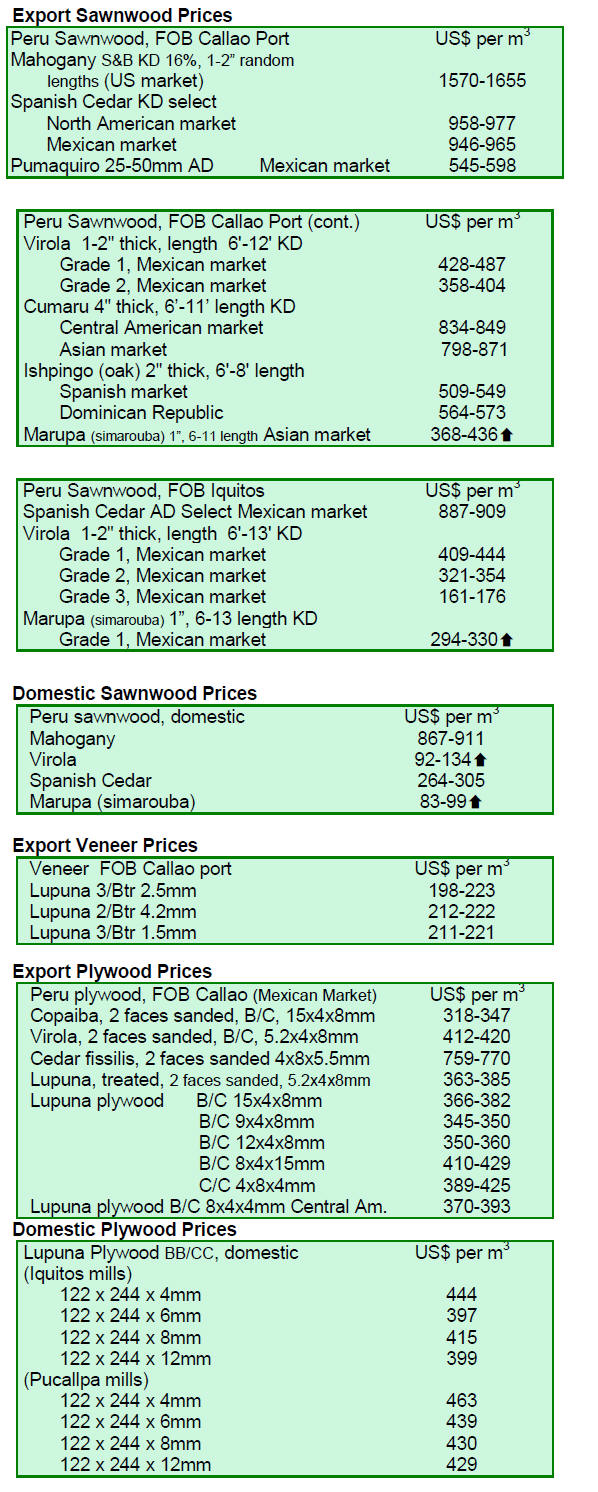
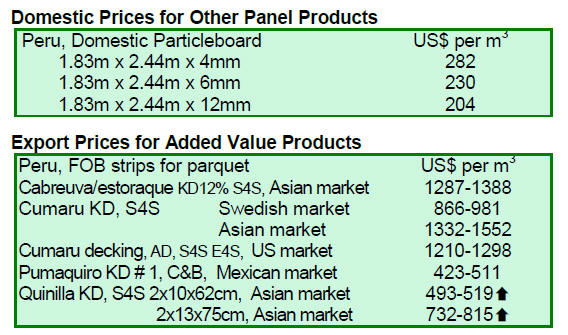
9.
GUYANA
Quiet log market but prices steady
The market for Guyana export logs remains very quiet and
only greenheart Standard Quality logs were shipped
(US$140 per cubic metre FOB).
Purpleheart Standard Quality logs were also shipped at an
average of US$385 per cubic metre FOB and
pricesremained firm in comparison to levels previously
reported. There were no exports of Mora logs during the
period reported.
Sawnwood prices trend weaker in slow market
FOB prices for Guyana sawnwood remain largely
unchanged. Undressed greenheart sawnwood FOB prices
rose from US$594 to US$775 per cubic metre.
Select Quality Undressed purpleheart top-end FOB prices
were slightly lower than over the past weeks, dropping
from US$1,080 to US$954 per cubic metre. In contrast,
Undressed purpleheart (Merchantable Quality) prices
remains stable at US$650 per cubic metre FOB.
Mora sawnwood was exported but FOB prices for
Undressed Mora (Select Quality) declined marginally
from US$672 to US$575 per cubic metre.
Weaker FOB prices were recorded for Dressed greenheart
sawnwood where top end prices fell slightly from
US$1,150 to US$1,102 per cubic metre during this period.
However, Dressed purpleheart top end FOB prices
remained firm at US$1,102 per cubic metre.
Ipe (Washiba) exports continue and FOB prices as high as
US$ 2,550 per cubic metre were recorded.
Export prices for non-traditional species have been
encouraging:
Darina (Angelim pedra) US$ 700 per cubic metre FOB
Kabukalli (Goupia glabra) US$ 742 per cubic metre FOB
Wamara (Swartzia leiocalycina) US$ 575 per cubic metre
FOB.
Some of the major destinations for Guyana‟s hardwoods
include the Caribbean, Europe, Middle East and North
America.
Guyana‟s roundwood (piles and posts) attracted good
prices on the export market with pile prices rising to as
much as US$400 per cubic metre FOB in the Caribbean
and North American markets. FOB prices for posts were
also favourable at an average of US$329 per cubic in the
Caribbean market.
Foreign investment boost to employment
Bai Shan Lin Forest Development Inc. president Chu
Wenzhe has unveiled plans for the establishment of a
wood processing plant in Linden in Region 10, the Upper
Demerara-Berbice region.
Region 10 borders Essequibo Islands-West Demerara,
Demerara-Mahaica and Mahaica-Berbice to the north, the
region of East Berbice-Corentyne to the east, and the
regions of Potaaro-Siparuni and Cuyuni-Mazaruni to the
west.
¡¡

Bai Shan Lin recent advertised vacancies for its
wood
processing and export operations.
The company has plans for production of value added
wood products and has ambitious plans for worker and
community services including a school and a hospital.
The Chinese company has been operating in the forestry
sector of Guyana for several years and has strategic
alliances with other companies in the wood processing and
value added wood sector.
Steps on the FLEGT roadmap
The Guyana Forestry Commission (GFC) recently hosted
a stakeholder workshop on three major elements in the
EU/GFC FLEGT Roadmap - draft Legality Definition, the
Communication Strategy and Scoping of Impacts.
The workshop was attended by over one hundred
participants from twenty eight communities and
discussions focused on the Legality Definition as it relates
to Amerindian Communities.
The Terms of Reference for the Communication Strategy
and the Scoping of Impacts were also discussed.
Communication Strategy and Scoping of Impacts
study
Work on drafting the communication strategy and scoping
of impacts study have been held and FAO has offered to
assist with the drafting of the communication strategy and
scoping of impacts.
A second technical meeting was held between the EU and
Guyana in mid March to discuss the legality definition.
Having benefited from comments on ways in which the
definition can be improved, the Guyana FLEGT
Secretariat will further produce a revised document for
presentation to stakeholder groups. The GFC is seeking
support so that it can engage a wider stakeholder group
and is discussing this with FAO.
The range of wood products to be included in the VPA has
been identified but the agreement allows for the possibility
of additions being built in after the VPA is ratified.
A final decision on the initial product list will taken in July
of 2013 during the second phase of the VPA negotiations
to be held in Brussels. An Aide Memoire for the first
negotiation session between EU and Guyana has been
finalised and is available on the Guyana Forestry
Commission website.
http://www.forestry.gov.gy/Downloads/FLEGT_EU_Guyana_Ai
de_Memoire_Nego1_Dec_5th_2012_Revised_April_10_13.pdf
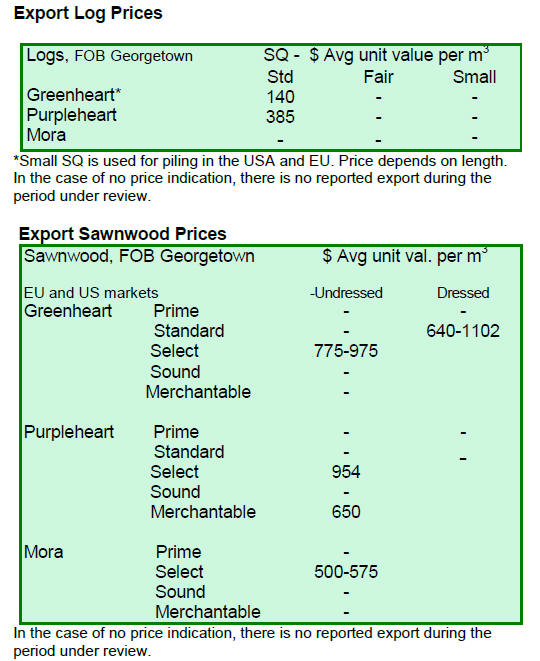

¡¡